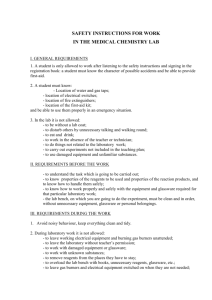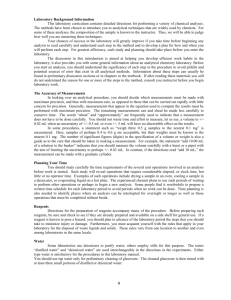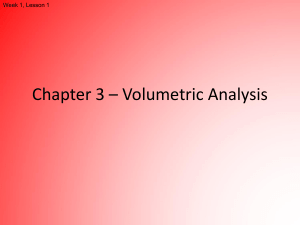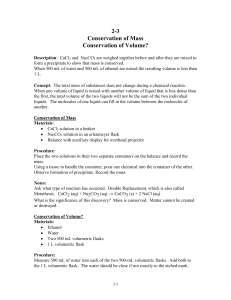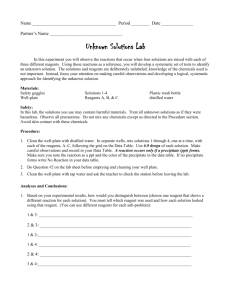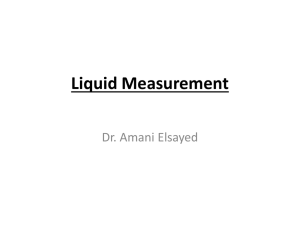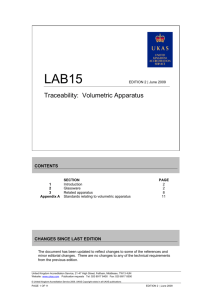The Case of the Unknown Solutions
advertisement
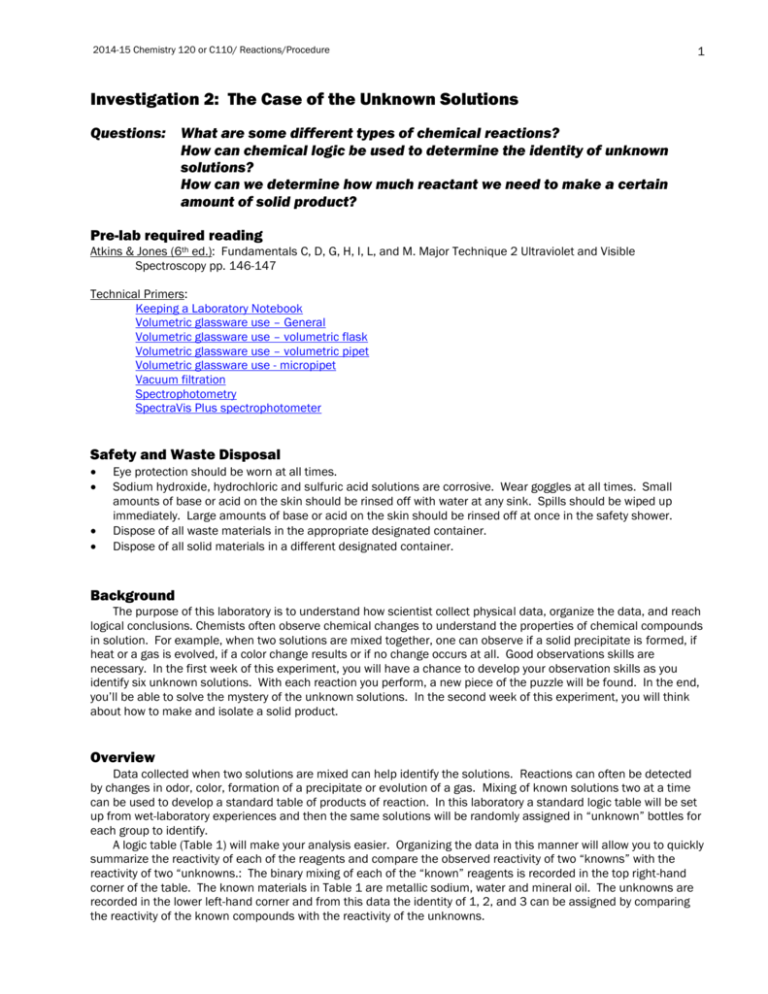
2014-15 Chemistry 120 or C110/ Reactions/Procedure 1 Investigation 2: The Case of the Unknown Solutions Questions: What are some different types of chemical reactions? How can chemical logic be used to determine the identity of unknown solutions? How can we determine how much reactant we need to make a certain amount of solid product? Pre-lab required reading Atkins & Jones (6th ed.): Fundamentals C, D, G, H, I, L, and M. Major Technique 2 Ultraviolet and Visible Spectroscopy pp. 146-147 Technical Primers: Keeping a Laboratory Notebook Volumetric glassware use – General Volumetric glassware use – volumetric flask Volumetric glassware use – volumetric pipet Volumetric glassware use - micropipet Vacuum filtration Spectrophotometry SpectraVis Plus spectrophotometer Safety and Waste Disposal Eye protection should be worn at all times. Sodium hydroxide, hydrochloric and sulfuric acid solutions are corrosive. Wear goggles at all times. Small amounts of base or acid on the skin should be rinsed off with water at any sink. Spills should be wiped up immediately. Large amounts of base or acid on the skin should be rinsed off at once in the safety shower. Dispose of all waste materials in the appropriate designated container. Dispose of all solid materials in a different designated container. Background The purpose of this laboratory is to understand how scientist collect physical data, organize the data, and reach logical conclusions. Chemists often observe chemical changes to understand the properties of chemical compounds in solution. For example, when two solutions are mixed together, one can observe if a solid precipitate is formed, if heat or a gas is evolved, if a color change results or if no change occurs at all. Good observations skills are necessary. In the first week of this experiment, you will have a chance to develop your observation skills as you identify six unknown solutions. With each reaction you perform, a new piece of the puzzle will be found. In the end, you’ll be able to solve the mystery of the unknown solutions. In the second week of this experiment, you will think about how to make and isolate a solid product. Overview Data collected when two solutions are mixed can help identify the solutions. Reactions can often be detected by changes in odor, color, formation of a precipitate or evolution of a gas. Mixing of known solutions two at a time can be used to develop a standard table of products of reaction. In this laboratory a standard logic table will be set up from wet-laboratory experiences and then the same solutions will be randomly assigned in “unknown” bottles for each group to identify. A logic table (Table 1) will make your analysis easier. Organizing the data in this manner will allow you to quickly summarize the reactivity of each of the reagents and compare the observed reactivity of two “knowns” with the reactivity of two “unknowns.: The binary mixing of each of the “known” reagents is recorded in the top right-hand corner of the table. The known materials in Table 1 are metallic sodium, water and mineral oil. The unknowns are recorded in the lower left-hand corner and from this data the identity of 1, 2, and 3 can be assigned by comparing the reactivity of the known compounds with the reactivity of the unknowns. 2014-15 Chemistry 120 or C110/ Reactions/Procedure 2 Table 1. A Chemical Logic Table Na H2O Mineral Oil No observable reaction Fire No reaction Na No observable reaction Two phases H2O No observable reaction Mineral oil 1 No observable reaction 2 Two phases 3 No reaction 1 No observable reaction fire 2 No observable reaction 3 From the data table the results are: Na=3; H2O = 2 and Mineral Oil =1 A general list of observations that you will need to make are described below, but you should realize that there might be other important observations that you should make. Observation of the pH Approximate pH values can be established using pH indicator paper. Do not place the pH paper in the solution, either on the well plate or in a test tube. Wet a class stirring rod in the solution of interest and touch the rod to the pH paper. Compare the wet paper to the pH-color chart on the pH paper container. Acidic solutions will have a pH less that=n seven (pH<7) and basic solutions will have a pH greater than seven (pH>7). All the individual solutions should be tested before reagents are mixed. The approximation of the pH of the reaction mixtures is unreliable and not useful. The pH values can vary several pH units upon the addition of even one extra drop of a reagent. Since the addition of reagents is always approximate for all the combinations, the pH values will not be accurate. Thus, do not waste time measuring pH once two solutions have been mixed. Observation of Color Change Each student should note any color change. If the solution turns brilliant orange, that is important. Color can be subjective, therefore the better the description, the easier the analysis will be. It is important to note if only the solution color changes or if something else is going on, if it becomes cloudy or opaque then a precipitate is likely to have formed. Observation of a Precipitate The formation of precipitates should be obvious. A concentration gradient is not a precipitate. A concentration gradient can be eliminated by ensuring that the mixture is completely homogeneous. Homogeneity can be accomplished by using a stirring rod to completely mix the solutions. If the solution is cloudy and there is uncertainty about the formation f a precipitate, it may be helpful to change the color of the background. If the well plate is clear, you can change the background by setting the plate on a black countertop, or on white paper. Observation of a Liberated Gas Liberated gases can be noted by looking for small bubbles that form after the reagents have been mixed. Be careful to describe the gas evolution as fully as possible to eliminate the possibility that the bubbles were caused by the mixing of the two solutions. The odor of the liberated gas should be observed carefully by drawing the vapors toward the nose with the hand. Do not place the well plate directly under the nose. Observation of “No Visible Change” “No Visible Change” is an important observation. Many of the binary combinations will produce “No Visible Change”. 2014-15 Chemistry 120 or C110/ Reactions/Procedure 3 Week one: Procedure The following 0.5 M solutions will be available: CoCl2 (aq) NaOH (aq) H2SO4 (aq) CuSO4 (aq) Na2CO3 (aq) HCl (aq) BaCl2 (aq) Cu(NO3)2 (aq) Preparing the Binary Combinations Obtain approximately 10 mL of each reagent listed above. Mix 0.5 mL of one of the eight solutions with 0.5 mL of another in a well plate. Note that 1 mL is approximately 20 drops from a disposable pipet. Carefully observe and record all results. Continue to combine two of the solutions in the same manner until all possible combinations of two solutions have been mixed and observed. Determining the Identity of Unknown Solutions In a chemical storage facility, someone accidently added food dye to some solutions that were going to be identified and discarded as hazardous or non-hazardous waste. Your company, Enviro-Clean, has been hired to determine the identity of the compounds and dispose of them according to EPA regulations. Your investigating team will be assigned 5 unknown solutions to investigate. Devise a method to systematically identify the unknown solutions. It has been determined that the food dye added may mask the color of the original solutions, but does not change how it interacts with other solutions. Carefully observe and record all results. Use your observations and chemical logic to determine the identities of the unknown solutions. Week two: Procedure Making a Solid and Observing color Spectrophotometrically The following 0.5 M solutions will be available: CoCl2 (aq) Na2CO3 (aq) Your company, Cool Colors Inc., has been hired to make a small amount of a purple solid, CoCO3 and to determine the maximum wavelength at which the pink solution absorbs visible light (the max). First, your team should use the spectrophotometer to determine the maximum wavelength of the colored solution. What is the maximum wavelength for each? What species in solution makes it look pink? At your facility, you can only mix 50mL amounts of two solutions at a time in your processor. Your investigating team must determine what stoichiometric concentrations of solutions could be used to make a 0.150g quantity of CoCO3 solid. To what concentration should the 0.5 M solutions available be diluted to make a solution with a stoichiometric amount of the reagent required to make 0.150g of CoCO3 (s)? How would your team use volumetric glassware to prepare the solutions? Once the appropriate solutions are prepared they can be mixed in a beaker to form the solid. The solid should then be isolated by vacuum filtration, rinsed once with distilled water, twice with ethanol, dried and weighed. Your team should determine the percent yield of your small batch synthesis. References Atkins, P.; Jones, L. “Chemical Principles: The Quest for Insight”, 6th ed.; Freeman: New York. 2013. March, J. Reaction Types and Chemical Logic. 1997, developed by Department of Chemistry, University of Wisconsin-Madison.
